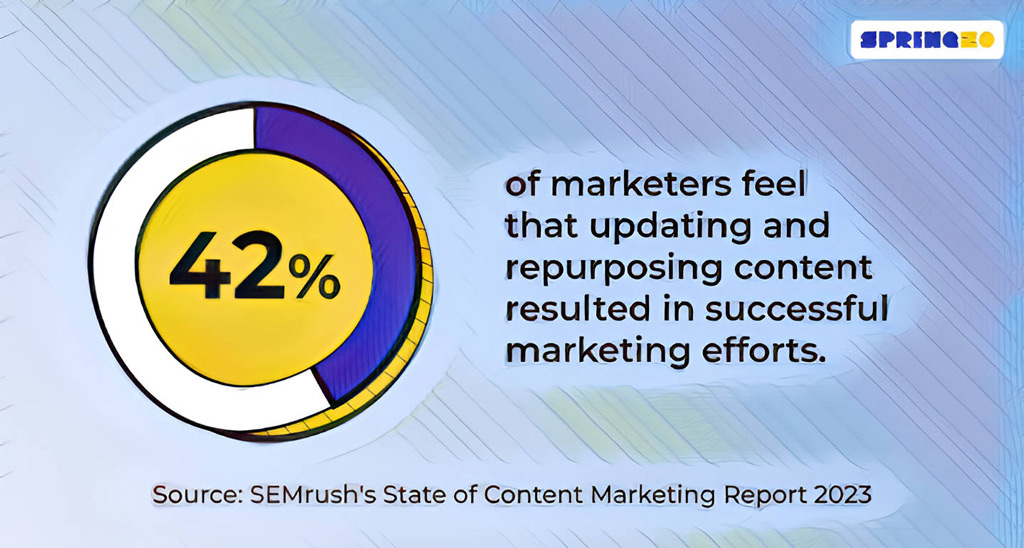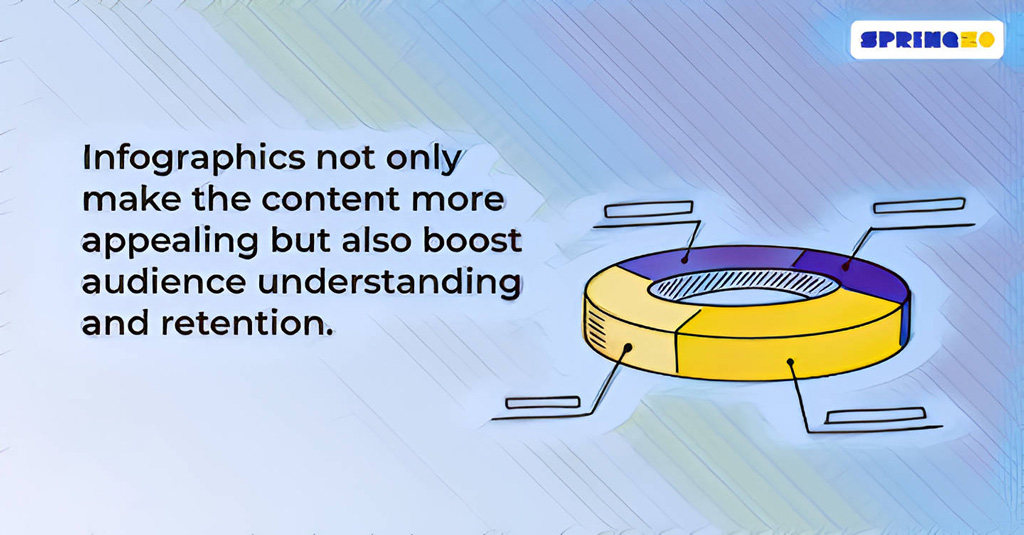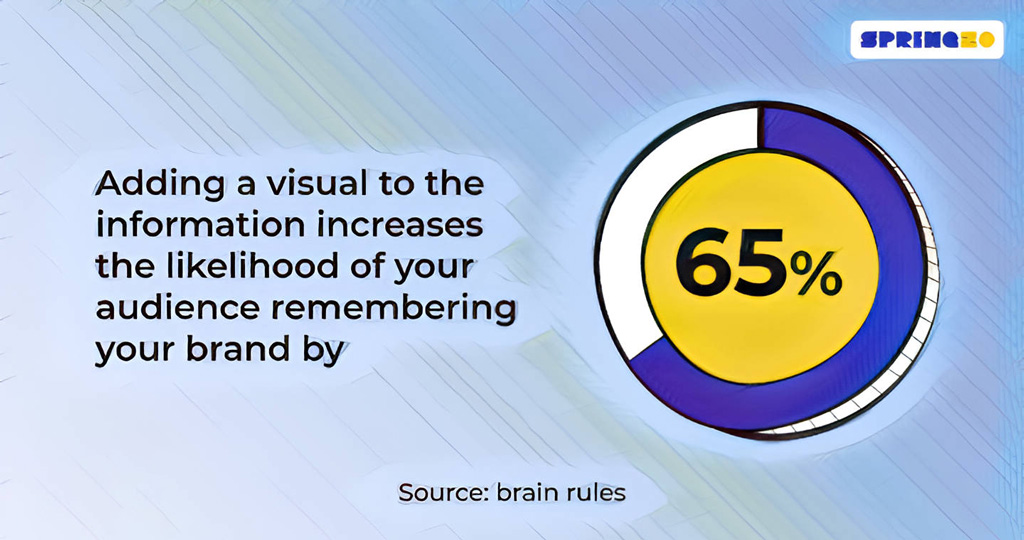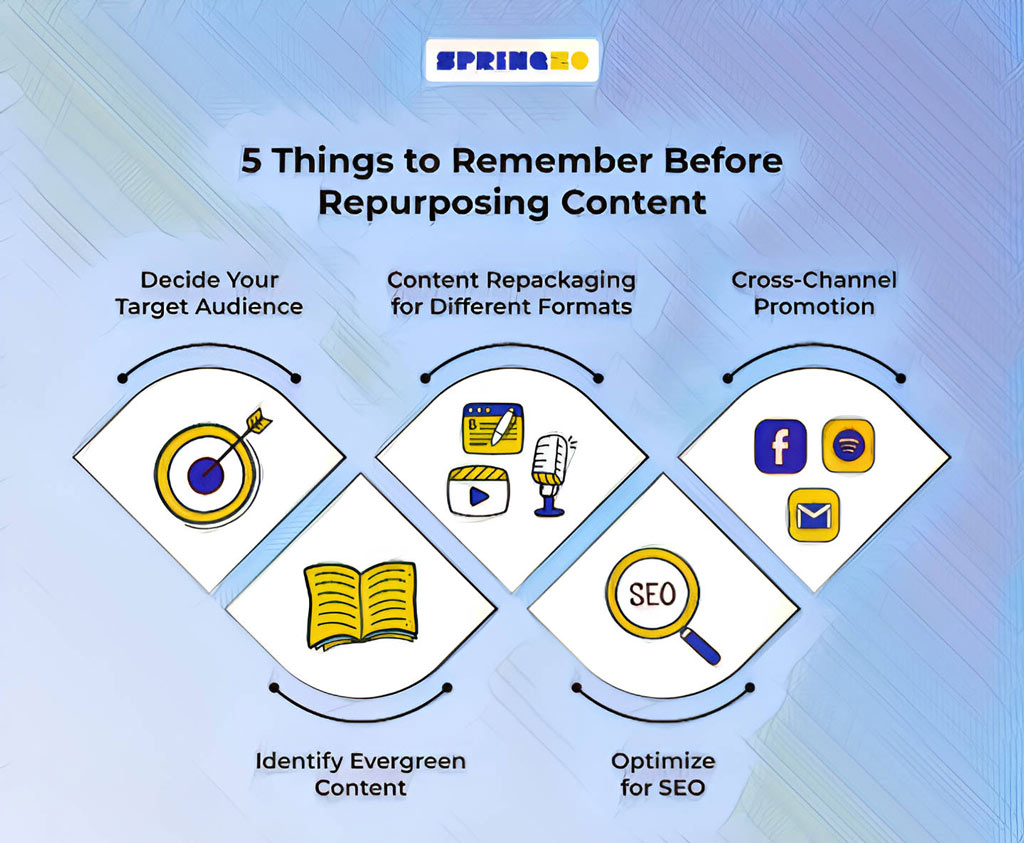The growing diversity of content online these days means marketers need to fight hard for their audiences’ attention. Not only is there a ton of different content, but brands are also competing with each other on various platforms to get noticed by the same audience.
So, the key to standing out in this crowded online space is to churn out high-quality content consistently. However, continuously generating fresh, premium content can be quite an uphill battle.
This is where the strategy of content repurposing steps in as a lifeline. With the right approach, content repurposing allows you to tap into your existing content, repackage it and present it in an engaging way to reach different audiences.
A recent ReferralRock survey suggests that a staggering 94% of marketers repurpose content. The remaining 6% want to use it in future marketing plans.
According to SEMrush’s State of Content Marketing Report 2023, 42% of marketers feel that updating and repurposing content resulted in successful marketing efforts. It effectively maximized resources, improved SEO, expanded reach, built brand awareness, and boosted engagement.

In this comprehensive blog post, we discuss content repurposing, how to do it effectively, and some vital approaches you can adopt for maximum results.
What is Content Repurposing?
Content repurposing involves converting existing content into different formats or platform-specific adaptations to cater to a broader range of audiences who have different preferences for consuming content. For example, a large pool of audience who prefer consuming visual content will not read your blog post, but they will watch your video.
When marketers repurpose content, they can maximize existing resources, reach a wider audience, and disseminate useful information through various channels, saving time and effort compared to creating new content.
Now, let’s look at some of the advantages of content repurposing that you should consider.
Content Repurpose: The Benefits
Content repurposing can offer a slew of benefits to your organization’s content production efforts, such as:
1. Brand Visibility Across channels
Converting content into various formats, such as audio, video, infographics, and podcasts, helps reach a wider audience in new markets with specific preferences.
Also, the content becomes available across multiple channels, like social media, email newsletters, and guest blogs, increasing brand visibility.
2. Optimized Use of Resources
High-quality content takes time and effort to produce. With content repurposing, you can reduce dependency on crafting content from scratch. According to the ReferralRock survey, For quick and striking results, 48% of marketers favor content repurposing. Auditing existing content and then remodeling it to a new format can recreate and revive value with less time and effort.
3. Enhanced SEO
When you refine and revitalize your old content with new keywords and search intents specific to your niche, you not only boost its visibility on search engine results pages, leading to enhanced SERP performance, but you also pull in more organic traffic over time. An important aspect that often goes unnoticed is that repurposing your content in this manner also helps you tap into a broader audience across various platforms, thereby increasing both direct and organic search traffic.
4. Sustainability and Longevity
Repurposing extends the lifespan of important content, making it relevant and valuable over time, especially if you use evergreen content.
5. Thought Leadership and Authority
Transforming content into various formats allows for presenting insights and ideas from multiple perspectives, establishing credibility as a thought leader in the industry.
Repurpose Your Content: 10 Ways To Do It
It’s crucial to embrace creativity and use a variety of content forms in order to enhance the effectiveness of reusing your material. But first, let’s see how content is usually repurposed.
1. Crafting White Papers or E-Books from Articles or Interviews
Combine a series of related articles or collate insights from numerous interviews to craft comprehensive whitepapers or ebooks. For example, if you run a health blog, several posts about nutrition can be amalgamated into an extensive ebook about healthy eating habits. This approach enriches your content library, establishing your brand as a thought leader in the industry and providing an educational resource for your audience.
2. Creating Infographics from Articles or Videos
Data-rich articles or video content can be transformed into infographics, a visually engaging format perfect for distilling complex topics. Consider a research article about the progression of AI technology; it can be reimagined as an infographic that depicts key advancements in a visually digestible timeline. Infographics not only make the content more appealing but also boost audience understanding and retention.

3. Morphing Podcasts into Articles
Expand the reach of your podcast series by transcribing episodes into blog posts or infographics. For instance, a podcast discussing the ten steps to start a small business can be converted into a step-by-step guide on your blog. You can also create episode summaries or listicles that highlight key points, urging your audience to listen to the entire podcast episode.
4. Making Videos from Articles or Interviews
Videos offer an immersive way to connect with your audience, narrate compelling stories, and position your brand strategically. Business Insider’s survey revealed that 62% of Generation Z use YouTube daily, emphasizing the potential reach of video content. Repurpose text-based articles or interview content into short or long-form videos. For instance, a customer interview about their experience with your product can be reworked into an engaging testimonial video, increasing your brand recall by 65%.

5. Formulating Guest Articles from Social Posts
Repackage your high-performing social media posts into guest articles for other platforms. If a LinkedIn post about the future of digital marketing garnered significant engagement, consider expanding it into a guest article for a marketing blog or magazine. This tactic boosts your visibility, establishes authority, and fosters connections with a new audience.
6. Extracting Social Media Snippets from Articles or Videos
Turn striking statements or key points from your articles or video content into engaging social media posts. For example, an informative video on climate change could be repurposed into a series of infographic posts for Instagram, each summarizing a specific point. These social media snippets not only enhance the content’s reach but also drive more traffic and encourage greater audience interaction.
7. Building Quizzes and Assessments from Articles or Social Posts
Convert factual content into interactive quizzes or assessments to engage your audience differently. If you have an article about popular travel destinations, transform it into a quiz titled “Which dream vacation suits your personality?” This approach encourages your audience to engage with your brand while offering a fun, educational experience.
8. Developing Articles from Case Studies
Reconstruct your case studies into informative articles, providing concrete examples and advice. A case study about a successful product launch can be reimagined as an article sharing practical tips for launching new products. These real-life examples help your audience understand how your insights can be applied, bolstering your credibility and showcasing the value of your expertise.
9. Generating Email Newsletters from Articles
Keep your audience up-to-date by repurposing your articles into regular email newsletters. A piece about the latest trends in eCommerce can be broken down into a series of emails, each focusing on a single trend. This format keeps your audience engaged, delivers valuable insights, and fosters a continuous relationship.
10. Converting Articles into Online Courses or Webinars
Turn your detailed articles into comprehensive online courses or webinars. An article about photography basics, for instance, can be transformed into a beginner’s photography course, providing an interactive learning platform that enhances understanding and skills.
10 Innovative Ways to Repurpose Content
Now that we’ve seen how content is typically repurposed, let’s look at some less common ways to do it.
1. Converting Podcast Episodes into Videos or Audiograms
Switching audio content to video format enhances its appeal and accessibility on platforms dedicated to video content. For instance, an episode from your wellness podcast can be repurposed into an animated video for YouTube or a series of insightful reels on Instagram. By doing this, you’re leveraging these platforms’ extensive user bases to widen your reach.
2. Constructing Slide Decks from Articles
Repurpose your articles or blog posts into visually stimulating slide decks. An article about ‘The Future of Renewable Energy’ can be transformed into an interactive PowerPoint presentation or an engaging webinar, fostering more profound understanding and increasing audience engagement.
Slide decks are great for sharing over professional platforms like LinkedIn and when done right, they also help with thought leadership.
3. Crafting Visual Quotes from Interviews
Extract compelling quotes from your interviews and create visually striking images for social media sharing. For instance, an inspiring quote from an interview with a successful entrepreneur can be repurposed into a graphic for Instagram, boosting motivation and engagement among your followers.
4. Designing Webcomic Strips from Social Posts or Articles
Convert your content into enticing webcomic strips. A social post on cybersecurity threats can be reimagined as a comic strip, infusing education with entertainment. This approach captivates your audience in a unique, enjoyable manner while still conveying crucial information.
5. Microblogging or Social Media Threads from Articles
Transform your long-form articles into digestible microblogs or social media threads for easy consumption and sharing. A comprehensive article on ‘The Impact of AI on Healthcare’ can be broken down into a Twitter thread, each tweet highlighting a key point, fostering engagement and discussions.
6. Converting Articles into PDFs
To create PDFs from articles, identify valuable content from your blog posts and amalgamate them into a cohesive guide. Streamline the content, incorporate visual elements, and align with your brand’s aesthetics. Once the design is complete, convert it into a shareable PDF format, perfect for reports, guides, or whitepapers.
What’s more, when you share PDFs on LinkedIn, they are easy to consume for the readers as they can simply keep swiping to the next page while reading it.
7. Crafting Case Studies from Testimonials
Testimonials can be the raw material for case studies that showcase the real-world efficacy of your product or service. Collect positive testimonials, unearth compelling success stories, and further interview those customers for additional insights. The case study should present a narrative of the problem, your solution, and the tangible results to reinforce authenticity.
8. Developing Ebooks from Case Studies
Ebooks derived from case studies offer a comprehensive way to impart deep insights. Choose case studies revolving around a common theme, say ‘Digital Marketing Success Stories.’ Format your ebook into chapters, each elaborating on a distinct case while weaving a narrative that ties it all together. Post design, publish, and promote your ebook across diverse channels to maximize reach.
9. Creating Audiobooks from Research Papers
Turn dense research papers into engaging audiobooks. A complex paper on ‘The Impact of Climate Change on Global Economies’ can be transformed into an accessible audiobook, making it easier for your audience to absorb the content during commutes or downtime. This way, you deliver in-depth knowledge in a more relaxed, palatable format.
10. Creating Stop Motion Videos from Infographics
Infographics can be elevated to an entirely new level of engagement by turning them into stop-motion videos. For instance, an infographic about ‘The Journey of Coffee from Bean to Cup’ can be repurposed into a captivating stop-motion video, making the information more dynamic and shareable, especially on social media platforms.
5 Things to Remember Before You Repurpose Content

To effectively repurpose content, follow these steps:
1. Decide Your Target Audience
This is the primary step before you publish your renewed content. Conduct thorough research to identify which customer segment you ought to target. Then try to learn about your target audience’s most-visited platforms, formats, and preferences. Create customized repurposed content as necessary.
2. Identify Evergreen Content
Prioritize repurposing timeless content, such as in-depth how-to manuals, documentation, or thought leadership pieces. These usually contain ample information to add sustainable value for your viewers.
3. Content Repackaging for Different Formats
To get your content to a wider audience, focus on making your content more platform-oriented and format-specific. Create a compelling video script from a blog post, or gather blog entries to create an e-book or webinar.
4. Optimize for SEO
On-page and off-page SEO still remains a key driver for growth, even in the era of ChatGPT. Conduct keyword research and carefully place relevant words and phrases. Improve discoverability by making titles, headers, and descriptions better.
5. Cross-Channel Promotion
Content repurposing is only half-done if you are not distributing it to the proper channels. Share your new refurbished content on:
- your website and blogs
- social media platforms such as Facebook, LinkedIn, Instagram
- email newsletters
- podcasting platforms like Spotify, SoundCloud
- video platforms like Youtube, TikTok, Vimeo
- content syndication networks like Outbrain, Taboola, etc.
This helps to attract new audiences and increase website traffic.
Conclusion
In the age of information overload and ubiquitous online platforms, content repurposing is an effective strategy to distinguish your brand and amplify its impact. At Springzo, we specialize in transforming your existing content into engaging pieces that captivate your audience, enhance reach, boost SEO, foster audience engagement, and establish thought leadership. Our content repurposing strategies not only provide a fresh spin to your material but also offer cost-effective and sustainable solutions for your business.
But that’s not all we do. Beyond repurposing, we are a comprehensive content creation agency. With our vast expertise, we cater to your entire content creation journey – from conceiving innovative ideas to crafting content primed for publishing. At Springzo, we’re not just about creating content; we’re about generating value, balance, and driving revenue. So, say farewell to crowded content marketplaces and freelancers, and embrace the Springzo experience. Call us today!
Frequently Asked Questions (FAQs)
1. What is content repurpose?
Repurposing content involves transforming it into various formats or adaptations that cater to various audience tastes and platforms in order to maximize resources and reach a larger audience.
2. What are the benefits of repurposing content?
Repurposing content expands the audience reach across a variety of media, increases brand awareness and website traffic, improves SEO, and develops deeper connections and more audience engagement.
3. How can I make my repurpose content stand out when everyone else is also repurposing theirs?
Standing out in content repurposing hinges on creativity, relevance, and quality. Understand your audience’s preferences, and accordingly choose diverse formats like infographics, videos, or podcasts. When repurposing, don’t merely repeat information; instead, provide fresh insights or in-depth perspectives. To enhance the appeal, ensure high-quality visuals, professional editing, and a consistent brand voice. This combination of strategies will make your content pop amid the abundance of repurposed content.
4. Content repurposing is supposed to save time, but it sounds time-consuming. So, is it suitable for everyone?
Initially, repurposing content may seem time-consuming as you plan what and how to repurpose it. However, once you have a strategy in place, it can save a lot of time in the long run. Instead of constantly creating new content from scratch, you’re using existing content as a base and adapting it into different formats.
That being said, it might not be suitable for everyone. If you’re a solo entrepreneur or small business owner with limited time, it may be more efficient to focus on creating a smaller amount of high-quality original content. On the other hand, for larger companies or those with a lot of existing content, repurposing can be a great way to maximize the value of the content you’ve already invested time and resources into creating.
5. Who needs content repurposing?
Almost any individual or business that produces content can benefit from content repurposing. Whether you’re a blogger, a business owner, a digital marketer, a large corporation, or even an educational institution, content repurposing can help you maximize your content’s reach and effectiveness.
By repurposing content, you can appeal to different audience segments, improve your SEO, increase your visibility across various platforms, and reinforce your key messages.
